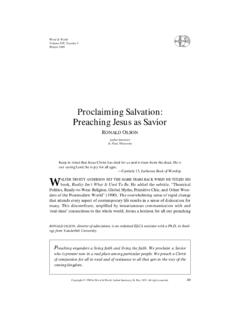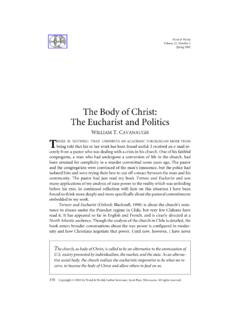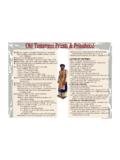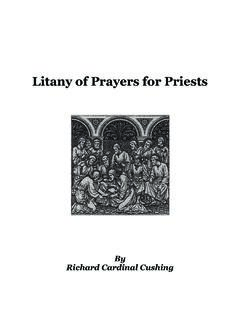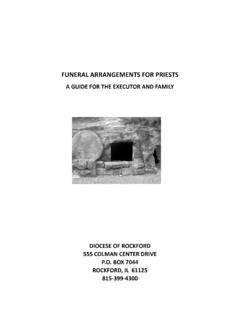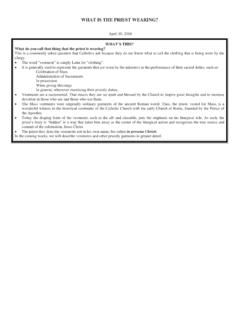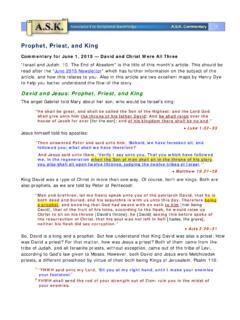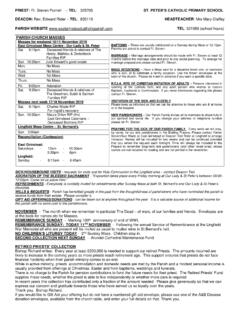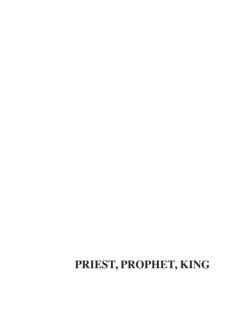Transcription of Priest, Prophet, Wisdom Teacher: Old Testament Models of ...
1 Word & World 9/4 (1989)Copyright 1989 by Word & World, Luther Seminary, St. Paul, MN. All rights 351 Priest, prophet , Wisdom Teacher: Old Testament Models of the Minister*DANIEL J. SIMUNDSONL uther Northwestern Theological Seminary, St. Paul, MinnesotaWhat is a minister, anyway? How are ministers different from other believers? Areligious community needs leaders. It will find some way to generate them, choose them, appointthem, and assign specific functions for them to perform. In ancient Israel, we hear about threedistinct types of religious leaders priest, prophet , and Wisdom teacher . By looking at each ofthese in some detail, perhaps we can learn something about the leadership needs of thecontemporary PRELIMINARY REMARKS1.
2 The church claims biblical authority, but on questions like this about the nature,structure, and function of ministry we rely almost wholly on post-biblical developments. Wemay not be able to move directly from forms of leadership in the Old Testament or NewTestament to the modern church, but that may make as much sense as to derive ministry modelsfrom some specific point in church history, say the third, fourth, fifth, or sixteenth a threefold model of ministry which included priest, prophet , and wiseperson wouldwork rather well. But what I am proposing here is considerably less modest. This study of OldTestament Models of ministry may not give us specific structures for our time, but it may raisetheological issues about how God speaks through human institutions, how the call comes and isverified by the community, and how the sacred traditions*This essay is based on a public lecture given by Prof.
3 Simundson at Luther Northwestern TheologicalSeminary on September 14, 352and practices of the past are renewed for each generation. What we can learn for our day may bemore by way of analogy and identification with these biblical forms than by copying In biblical times (and probably in other times as well), leadership moves from lessdifferentiated roles in formative times to more specialization as the community develops. Mosesis claimed by priests, prophets, scribes, and Wisdom teachers. He was simply Moses. Samuel, animportant transition figure during the move from a less structured society to the complexities ofmonarchy, was named as seer, judge, possibly priest (he studied with Eli), and prophet .
4 Later,Moses shares some of his charisma with others (Exod 18:19-22; Num 11:11ff.), and Samuel svarious offices are divided among kings and prophets. As New Testament ministry developed, itwas decided that the apostles should devote themselves to preaching the Word of God and prayerand let someone else serve tables and handle the administration (Acts 6:1-6).In monarchic times, we know that the religious leadership could be differentiated into atleast three main types priest, prophet , Wisdom teacher . Those conspiring against Jeremiah said, Come let us make plots against Jeremiah, for the Law shall not perish from the priest, norcounsel from the wise, nor the word from the prophet (Jer 18:18).
5 In Ezekiel 7:26: Disastercomes upon disaster, rumor follows rumor; they seek a vision from the prophet , but the lawperishes from the priest, and counsel from the elders. 3. There is diversity within each of these three groupings and there is uncertainty amongbiblical scholars about a number of matters, such as how they are chosen (or called), trained,paid, and what specific functions they performed. There are huge gaps in our understanding ofeach. But we do know something. We can make some generalizations-and that is what we will bedoing THE PRIESTWho is the priest? What does he do? How is he chosen?
6 Some Protestants, at least thosewho grew up in a low church tradition, do not particularly like the word priest and hesitate toclaim it for themselves. But the priest s function may be most like what we think of as the role ofthe ordained minister. The blessing of Levi by Moses (Deut 33:10) gives an indication of whatthe priest was called to do: They shall teach Jacob thy ordinances and Israel thy law; they shallput incense before thee, and whole burnt offering upon thy altar. Teach the torah and tend to thealtar-it sounds like Word and Sacrament ministry. Malachi 2:4-7 provides some words aboutGod s covenant with Levi: True instruction was found in Levi s mouth, and no wrong wasfound on his lips.
7 He walked with me in peace and uprightness, and he turned many frominiquity. For the lips of a priest should guard knowledge, and humans should seek instructionfrom his mouth, for he is the messenger of the Lord of hosts. The priest is the one who brings the means of grace to people. He is the custodian of theholy things, the sacred symbols. The priest ministers to people at important points in their lives(in the life stages of individuals, the yearly cycles of nature, and the structured remembrance ofGod s activity in the past).The priest is the teacher of the tradition. One theory about the structure of the book ofDeuteronomy is that it reflects the homiletical style of Levite priests whopage 353were responsible to pass on the story of God s dealings with the people from one generation tothe next.
8 (See, for example, Neh 8:1-9 where the priests teach the law of Moses to the peoplewho are gathered at the water gate.)The priest is the one who lives with people over the long haul, who makes a commitmentto be with them and help them through the stages of life. The priest does the in-house work ofthe minister: taking care of the flock, preaching, teaching, administering the sacraments,nourishing, priest is chosen by the religious community. Priests are set aside as special everyone can serve in this office. To begin with, he must be male and he must belong to aspecific family. We would not want to follow that tradition with regard to those matters.
9 Theimportant point to consider here is the more general one: the community decides whom it is not a charismatic choice ( God called me to do this ). It is not only or primarily a personalvocational decision. The priesthood is a self-perpetuating class of people. There is a well-definedsystem of accreditation. The church in our day will continue to insist on deciding whom it wantsto carry on its priestly functions, though it will surely use different criteria than those of THE PROPHETSome prophets were also priests , Jeremiah, Ezekiel, maybe Isaiah. So, thesefunctions are not necessarily mutually exclusive.
10 (This can be an important point to consider aswe wonder whether modern-day priests can carry on prophetic tasks.) It is important to note,however, that Jeremiah and Ezekiel are priests who can no longer operate as priests Jeremiahbecause centuries earlier his family sided with the wrong son of David and was banished toAnatoth, and Ezekiel because he had been deported to Babylon and no longer had access to thetemple. (Again, this may give us some insight about why a priest sometimes acts more like aprophet.)The emphasis with the prophet is on a direct Word from God, an immediate relevance,bypassing normal institutional channels-though the prophet , too, may become institutionalized( , cult prophets like Micaiah ben Imlah [1 Kings 22]; false prophets like Hananiah [Jer 28].)


